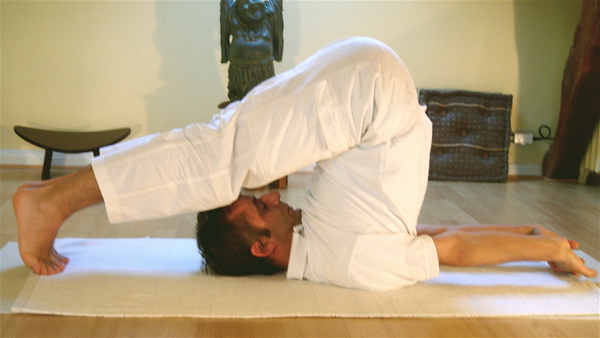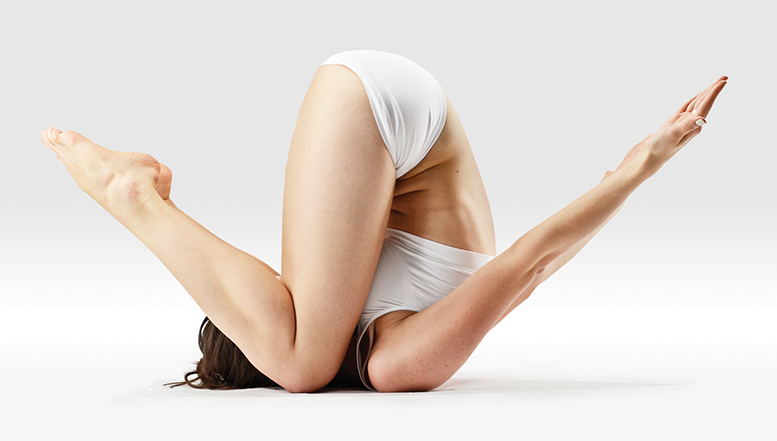Karnapidasana on:
[Wikipedia]
[Google]
[Amazon]
 Halasana (
Halasana (

 The name Halasana comes from Sanskrit हला ''hala'', " plough" and आसन ''āsana'', "posture" or "seat". The pose is described and illustrated in the 19th century ''
The name Halasana comes from Sanskrit हला ''hala'', " plough" and आसन ''āsana'', "posture" or "seat". The pose is described and illustrated in the 19th century ''
 Karnapidasana (ear-pressing pose) or Raja Halasana (royal plough pose) has the knees bent close to the head and grasped by the arms.
Parsva Halasana (sideways plough) has the body vertical, the trunk twisted to one side, and legs out straight with the feet touching the ground (to that side).
Supta Konasana (supine angle pose) has the legs as wide apart as possible, the toes on the ground, like an inverted Upavistha Konasana; the fingertips may grasp the big toes.
All these variations may be performed as part of a cycle starting from Sarvangasana (Shoulderstand).
Karnapidasana (ear-pressing pose) or Raja Halasana (royal plough pose) has the knees bent close to the head and grasped by the arms.
Parsva Halasana (sideways plough) has the body vertical, the trunk twisted to one side, and legs out straight with the feet touching the ground (to that side).
Supta Konasana (supine angle pose) has the legs as wide apart as possible, the toes on the ground, like an inverted Upavistha Konasana; the fingertips may grasp the big toes.
All these variations may be performed as part of a cycle starting from Sarvangasana (Shoulderstand).
Halasana Overview
{{Hatha yoga Inverted asanas Forward bend asanas ru:Перевёрнутые асаны#Сарвангасана
 Halasana (
Halasana (Sanskrit
Sanskrit (; attributively , ; nominally , , ) is a classical language belonging to the Indo-Aryan branch of the Indo-European languages. It arose in South Asia after its predecessor languages had diffused there from the northwest in the late ...
: हलासन; IAST: ''halāsana'') or Plough pose is an inverted asana in hatha yoga and modern yoga as exercise
Yoga as exercise is a physical activity consisting mainly of postures, often connected by flowing sequences, sometimes accompanied by breathing exercises, and frequently ending with relaxation lying down or meditation. Yoga in this form has ...
. Its variations include Karnapidasana with the knees by the ears, and Supta Konasana with the feet wide apart.
Etymology and origins

 The name Halasana comes from Sanskrit हला ''hala'', " plough" and आसन ''āsana'', "posture" or "seat". The pose is described and illustrated in the 19th century ''
The name Halasana comes from Sanskrit हला ''hala'', " plough" and आसन ''āsana'', "posture" or "seat". The pose is described and illustrated in the 19th century ''Sritattvanidhi
The ''Sritattvanidhi'' (, "The Illustrious Treasure of Realities") is a treatise written in the 19th century in Karnataka on the iconography and iconometry of divine figures in South India. One of its sections includes instructions for, and ill ...
'' as ''Lāṇgalāsana'', which also means plough pose in Sanskrit.
Karnapidasana is not found in the medieval hatha yoga texts. It is described independently in Swami Vishnudevananda's 1960 '' Complete Illustrated Book of Yoga'' in the Sivananda Yoga tradition, and by '' B. K. S. Iyengar'' in his 1966 '' Light on Yoga'', implying that it may have older origins. The name comes from the Sanskrit words ''karṇa'' (कर्ण) meaning "ears", ''pīḍ'' (पीड्) meaning "to squeeze", and ''āsana'' (आसन) meaning "posture" or "seat".
Description
The pose is entered from Sarvangasana (shoulderstand), lowering the back slightly for balance, and moving the arms and legs over the head until the outstretched toes touch the ground and the fingertips, in a preparatory variant of the pose. The arms may then be moved to support the back into a more vertical position, giving a second variant pose. Finally, the arms may be stretched out on the ground away from the feet, giving the final pose in the shape of a traditional plough.Variations
 Karnapidasana (ear-pressing pose) or Raja Halasana (royal plough pose) has the knees bent close to the head and grasped by the arms.
Parsva Halasana (sideways plough) has the body vertical, the trunk twisted to one side, and legs out straight with the feet touching the ground (to that side).
Supta Konasana (supine angle pose) has the legs as wide apart as possible, the toes on the ground, like an inverted Upavistha Konasana; the fingertips may grasp the big toes.
All these variations may be performed as part of a cycle starting from Sarvangasana (Shoulderstand).
Karnapidasana (ear-pressing pose) or Raja Halasana (royal plough pose) has the knees bent close to the head and grasped by the arms.
Parsva Halasana (sideways plough) has the body vertical, the trunk twisted to one side, and legs out straight with the feet touching the ground (to that side).
Supta Konasana (supine angle pose) has the legs as wide apart as possible, the toes on the ground, like an inverted Upavistha Konasana; the fingertips may grasp the big toes.
All these variations may be performed as part of a cycle starting from Sarvangasana (Shoulderstand).
See also
*List of asanas
An asana is a body posture, used in both medieval hatha yoga and modern yoga. The term is derived from the Sanskrit word for 'seat'. While many of the oldest mentioned asanas are indeed seated postures for meditation, asanas may be standing, seat ...
References
Sources
* * *External links
Halasana Overview
{{Hatha yoga Inverted asanas Forward bend asanas ru:Перевёрнутые асаны#Сарвангасана